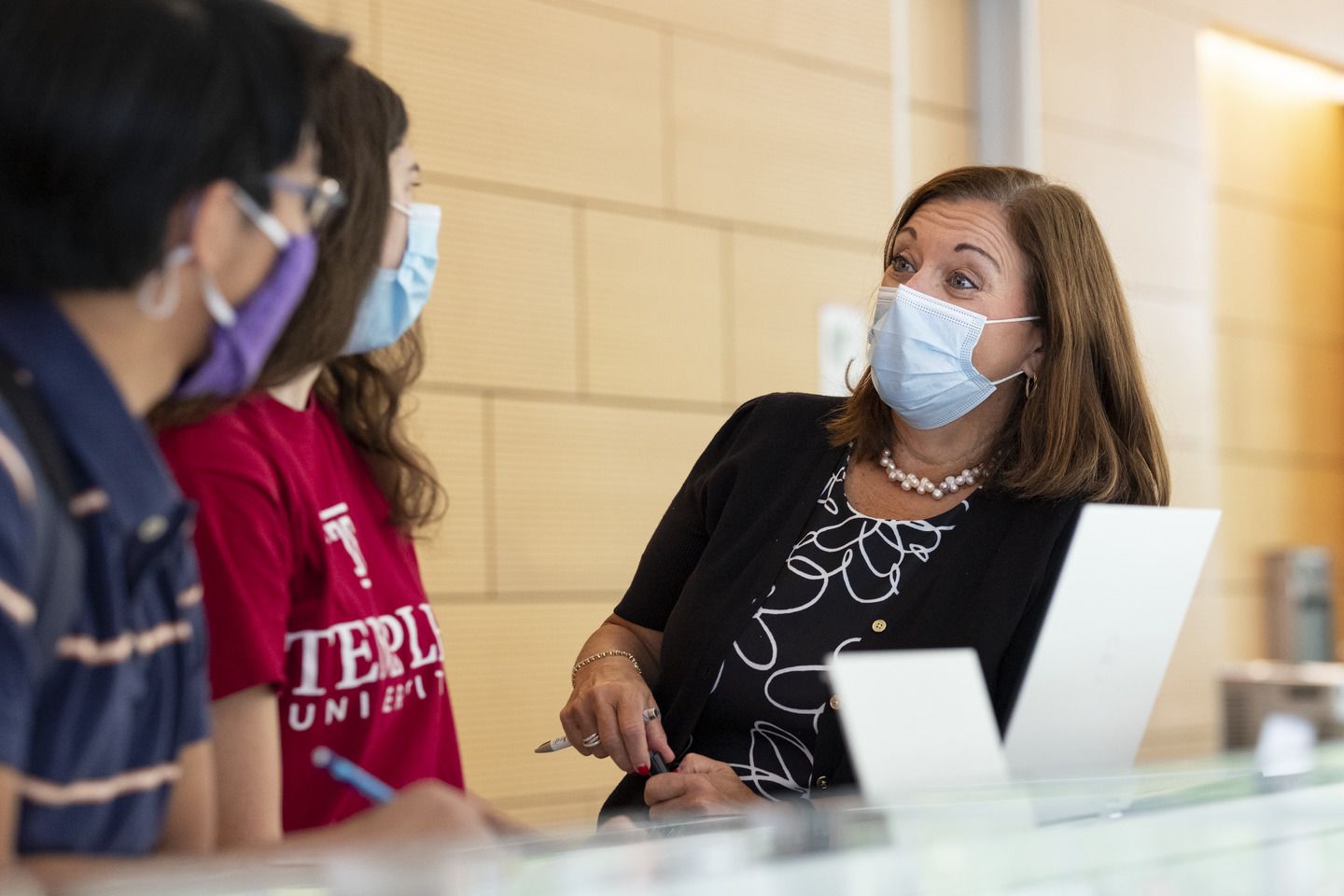Time is money
How three CIS students stayed on course during the pandemic and streamlined an unruly database for a local nonprofit

Despite a shift to remote learning, a group of CIS students completed their senior capstone project without a hitch—building a software program
to improve efficiency for a North Philadelphia
job readiness program.
“Does anyone here have an Excel spreadsheet that keeps them up at night?”
Rose McGinnis, assistant professor of instruction in computer and information sciences and director of student professional development and the data science programs in the College of Science and Technology, was speaking to a group of area nonprofit organizations supported by Temple’s Lenfest North Philadelphia Workforce Initiative (LNPWI) in fall 2019. She was trying to determine which of the groups might benefit from the services of the aspiring software developers in an upcoming computer and information sciences (CIS) senior capstone project course.
“I want you to think about an Excel spreadsheet that you may be running your entire operation on,” she added. “If you have one of those, we can help you with that.”
The statement resonated with Mattingly Cohen of Esperanza, a national organization with the mission of supporting the Hispanic community. Cohen works out of the organization’s Hunting Park Avenue location and is the program coordinator for their Alivio Project, which was selected in the summer of 2019 as one of LNPWI’s 11 funded partner projects.
Alivio is a pilot program that helps single mothers return to the workforce. It provides them with job readiness training, support services, funding and assistance—and tracking the participants’ progress through the program is an important part of Cohen’s job.
“I had everything in an Excel spreadsheet,” Cohen explained. “All of my notes and all of the information that I have to use to report on, defend and get funding for my project, and if anything ever happened to it, I don’t know what I would have done.”
McGinnis assigned the project to a group of students in the spring 2020 capstone she was teaching and they got to work.


Coding campus
Since 2012, McGinnis’s CIS students have been getting real-world experience by coding projects for departments across the university through two semesters of capstone courses, Information Systems Analysis and Design and Information Systems Implementation, in which they focus on the analysis and design of a system for a client.
Over the years, they’ve created a tool allowing the Resnick Academic Support Center to survey and track incoming student-athlete needs, a system that helps the Office of the Provost track and expedite a stipend program for qualifying students, and a slew of systems for the University Registrar.
In 2019, McGinnis expanded to include organizations throughout Philadelphia among the clients her students engage. To date, more than 125 systems have been developed.
The classes practice what’s known in the field as “agile software development,” a methodology that requires collaboration and nimbleness and encourages continuous improvement: In teams, the students cycle through a process of developing, testing, iterating and building their product.
Rob Zahorchak, who works full time as a technical lead at Vanguard, joined McGinnis in 2017 as an adjunct instructor to lead the students through the development and delivery of their systems. He ensures the students master the most current software development techniques before leaving Temple.
“We follow a human-centered approach to design, grasping what the client needs and then implementing it,” Zahorchak explained.





Switching gears
Then, as it did everyone else, 2020 threw McGinnis a curveball. In March, as the COVID-19 pandemic spread worldwide, Temple was forced to transition unexpectedly to a remote learning environment. The shift required McGinnis to be as nimble and flexible in her approach to the course as she had been asking her students to be during their software development process.
“I really had to stop and think, ‘OK, how do I do this,’” said McGinnis. “How do I approach this completely differently?”
She took advantage of the training and the resources the university offered both at the Center for the Advancement of Teaching and from the College of Science and Technology, and she redesigned the whole course to be a “flipped classroom.”
In a flipped classroom students are introduced to content at home and practice working through it at school. It’s the reverse of the more traditional practice of introducing new content at school, then assigning homework and projects to be completed by the students independently at home.
“It was a lot of work, but I think it works great,” McGinnis explained. “Now the class is structured so that the lectures are asynchronous, and then we have three synchronous Zoom meetings a week where we are really focused on group collaboration. So that’s when the students work together in their groups and we set up breakout rooms with myself and my TA.”
It’s worked out so well that McGinnis says she will continue to follow her newly designed course structure even as the university returns to primarily in-person instruction.
“For technology students, half of them are going to work remotely probably for the rest of their lives,” said McGinnis. “So, in many ways this is a skill set we’re now giving them that will actually be very, very beneficial to them as they move forward in their future careers.”
And that’s just icing on the cake. McGinnis’s students already enter the workforce more than prepared and frequently graduate with jobs in hand.
Putting the pieces together
The students took the transition to remote instruction in stride and, like McGinnis, gave the overall experience an A+.
Despite being limited to meeting only in virtual spaces with each other and with Cohen, the students were able to accomplish their goals.
“Going virtual for the capstone course—which is, of course, big on collaboration and developing a team dynamic—was off-putting and scary at first,” said Tyler Doudrick, CST ’20, who started in a full-time position as an application developer at Vanguard in February following his December graduation. “But our generation is really, really good at just picking up technology and communicating with it. So we were still able to figure it out and we were pretty much constantly chatting online about things—with each other and with our client.”
“The best part of the capstone was that we got to use all of the information that we learned throughout our entire degree and also help out members of the community, which is pretty cool,” he added.
Megha Patel, CST ’21, agreed. “In the beginning of our program we’re learning a lot, but it’s all very conceptual and abstract, and it’s hard to see how it’s all connected,” she said. “And then in this project we are literally seeing how everything we studied comes together in one place.” Patel began a full-time position at FAST Enterprises following her graduation in May.
For Alex Perez, CST ’20, the process of interviewing an actual client to understand her needs; hearing from the client as she tested out the system; and ultimately implementing technology to improve an organization’s security, efficiency and productivity was eye-opening: “To see our work actually helping real people was life-changing.”
Watching the students put all the pieces of the curriculum together to make an impact in the real world never gets old for Jamie Payton, professor and chair of the Department of Computer and Information Sciences.
“It is incredibly exciting to see all of the elements of our students’ computing education come together in these capstone projects—students have opportunities to work collaboratively and apply their creativity, knowledge and skills in computing to solve a real-world problem of importance for others within our community using technology,” she said. “It doesn’t get better than that.”

Dollars and sense
What the CIS students do for organizations like Esperanza is almost priceless. Many nonprofits do not have enough room in their budgets to afford what the CIS students do, at no cost. Purchasing a license for the use of a proprietary software can cost thousands of dollars. And finding the right application and tailoring it to fit a specific business model or an organization’s unique needs can be extremely difficult and time consuming as well.
After roughly two semesters of biweekly Zoom meetings with Cohen, and countless hours spent coding and testing the system, Doudrick, Patel and Perez delivered their final product complete with a 100-page user manual.
“The Temple students did just a fabulous job of listening first and understanding how our program worked and performing a needs assessment, so that the final product matched perfectly what I needed,” explained Cohen.

Coding community
Through its work with more than 20 community, university and employer partners, Temple’s Lenfest North Philadelphia Workforce Initiative provides job training and career readiness programs that lead to sustainable employment for North Philadelphia residents.
To date, LNPWI has engaged Temple’s CIS students in five projects with its community partners, including the one with Esperanza.
“The CIS students, completing their capstone project in their final year at Temple, are amazingly creative and thoughtful,” said Shirley Moy, executive director of LNPWI. “I continue to have such great experiences with the CIS students, and I encourage other nonprofits to take advantage of what they are offering.”
Cohen describes the impact of the Temple students this way: “It’s a big help because now a lot of what I was doing by hand and might have taken me hours is automated, including distributing reports—no more sending out multiple password-protected spreadsheets—and in addition the clients’ information is now more secure.”
“For nonprofits like ours, time is money and this application saves me time,” said Cohen.




